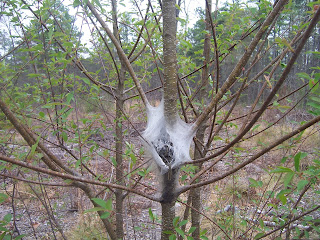If you're noticing that it's longer and longer between my blog posts, it's partly because circumstances force me to compose them in stages. For example, two sessions to load pictures, another to write copy. And with the pleasantly busy schedule I'm having with babysitting, getting in next year's wood supply, and an assortment of volunteer activities, blogging sometimes has to be squeezed in. Or squeezed out, as the case may be.
Anyway, today I'd like to share some photos of wildflowers, shrubs, and trees that I've observed while cutting firewood on the back of our property. Some of these are plants Judy and I have observed in the past; others are new and surprising.
We first noticed these last year, but the patches have grown and multiplied.
If you're familiar with conventional nursery-bought irises, you'll recognize that the wild variety is basically a miniature version.
I don't know the name of this shrub, but you can't miss its white flower clusters in the woods. When its leaves emerge, I may be able to identify it.
In this medium-sized wild cherry tree is a familiar sight-- a web full of American tent caterpillars. Oh, we can't wait to introduce the grandbabies to these.
If Bri and Claire take after Amanda, this "hanger-on" will soon have a name. How about Mortimer or Prissy?
Okay, it's a little embarrassing to admit that I don't know what this one is, either. I'm supposed to know something about wildflowers. But I lean heavily on my resource books when I come to something unfamiliar. And sometimes that fails me, too.
Very near a patch of wild irises I noticed a similar-looking purple flower, but with very different leaves. In one of my wildflower guides I discovered it is Birdfoot Violet.
One plant Judy and I couldn't get a close look at, but is most easily observed in this bare tree, is mistletoe. We're still working on how to get some down. Some way that doesn't involve climbing or a shotgun. Stay tuned.
I'll close this little botanical session with one of my favorite plants, Wild Ginger. It is fairly prevalent on our nature trail at school, but this was the first time I could recall finding any on our property. Again, according to my guide book, its acrid taste protects it from most plant-eating creatures. It has a wonderful exotic smell, though, and I can pluck a single leaf, tearing off a tiny portion for each member of an entire class to smell (and keep, if they wish).
One of the other interesting things about Wild Ginger is its unique flowers. Sometimes called pignuts (we have nicknamed them "little piggies"), they are ground-hugging and have an odor like rotting meat that attracts pollinating flies (I've never even noticed that odor, but then, I'm not a fly). After the seeds form, ants carry them away but eat only the seed coats, thus spreading the plant. I simply must repeat, doesn't God think of EVERYTHING!?
I haven't even gotten around to the ferns (ebony spleenwort, cinnamon fern, lady fern, and bracken fern, for starters) or the highbush and lowbush huckleberries. But my main point is, it's a thrill each year to be out among God's creation, being reminded anew that He is indeed the Master Designer..jpg)



















No comments:
Post a Comment